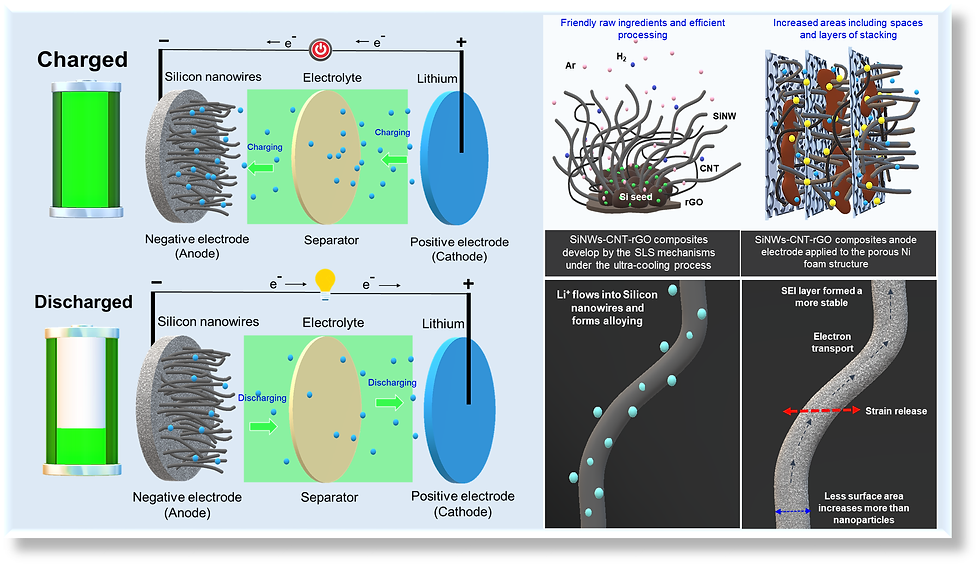
Silicon nanowires (SiNWs) address key challenges associated with traditional silicon anodes in lithium-ion batteries (LIBs) by mitigating pulverization and providing efficient ion transport pathways. However, their high fabrication cost and poor structural stability remain significant obstacles. This study presents a novel SiNW-CNT-rGO composite fabricated via a solid-liquid-solid (SLS) growth mechanism using NiO/Ni catalysts to establish a 3D conductive network. The composite integrates carbon nanotubes (CNTs) and reduced graphene oxide (rGO) to enhance electrical conductivity and stabilize the solid electrolyte interphase (SEI). Embedding the composite in 3D nickel foam (NF) further improves structural integrity and enhances Li+ ion diffusion, outperforming conventional copper foil (CF) current collectors in capacity across various rates. The integrated design provides efficient electron and ion transport pathways while mitigating mechanical stresses. Electrochemical evaluations reveal that the SiNW-CNT-rGO@NF anode significantly improves specific capacity, cycling stability, and rate capability compared to SiNW-based anodes with CF. These findings reveal the potential of the 3D SiNW-CNT-rGO@NF architecture as a scalable and cost-effective solution for next-generation high-performance LIBs.

The occurrence of Coulombic efficiency (CE) troughs in silicon (Si) anodes for lithium-ion batteries (LIBs) presents a critical yet overlooked concern that could lead to battery failure in full cells. Here we conduct a comprehensive investigation into this previously unreported phenomenon. Factors influencing CE trough occurrence and severity, including electrode thickness, Si particle size, cycling rate, electrolyte composition, and voltage window, are systematically examined. Experimental results demonstrate that thinner electrodes and slower cycling rates accelerate CE trough onset, whereas employing a THF-based electrolyte or a narrower voltage window (0.01-0.5 V) results in stable electrochemical performance without CE troughs, concurrently with the presence of LixSi. Structural analysis via HAADF-STEM and SEM reveals a close association between CE trough severity, electrode volume expansion, and delamination, influenced by the formation of a sponge-like structure and SEI stability. These findings yield valuable insights into CE trough mechanisms and provide guidance for mitigating their occurrence through electrode design, electrolyte selection, and operational parameters, thereby advancing high-performance LIB development. Future research directions involve exploring the role of SEI components and alternative electrolyte additives to enhance SEI stability and mitigate CE troughs.

Silicon-based anodes are considered a promising alternative for next-generation lithium-ion batteries (LIBs) due to their high theoretical capacity, which is significantly greater than that of traditional graphite anodes. However, the inherent challenge of the associated low initial Coulombic efficiency (ICE) due to irreversible lithium consumption limits their practical applications. Prelithiation techniques have emerged as a solution to compensate for this initial lithium loss, but current methods often face challenges such as high costs, incomplete lithiation, and complex setups. In this study, we present a novel modified direct contact prelithiation method utilizing a Li-ion-free biphenyl solution. This innovative approach integrates the advantages of both direct contact and wet chemical prelithiation, achieving fast, uniform, and cost-effective prelithiation of Si-based anodes. Electrochemical characterizations demonstrate that the method significantly enhances ICE, reaching from 66.7% to 115.4% after 10 minutes of prelithiation for SiOx anodes and from 91.4% to 100.5% after just 90 seconds of prelithiation for Si anodes, while also stabilizing open-circuit voltage. Furthermore, microstructural analyses reveal the formation of a distinct solid electrolyte interphase layer after prelithiation. XPS depth profiling confirms the progressive lithiation of Si-based anodes, highlighting the formation of lithium oxide and lithium silicate compounds at varying depths with extended prelithiation times. These findings demonstrate the effectiveness of the proposed integrated prelithiation method in enhancing the electrochemical performance of Si-based anodes, paving the way for the development of high-energy-density LIBs.








































